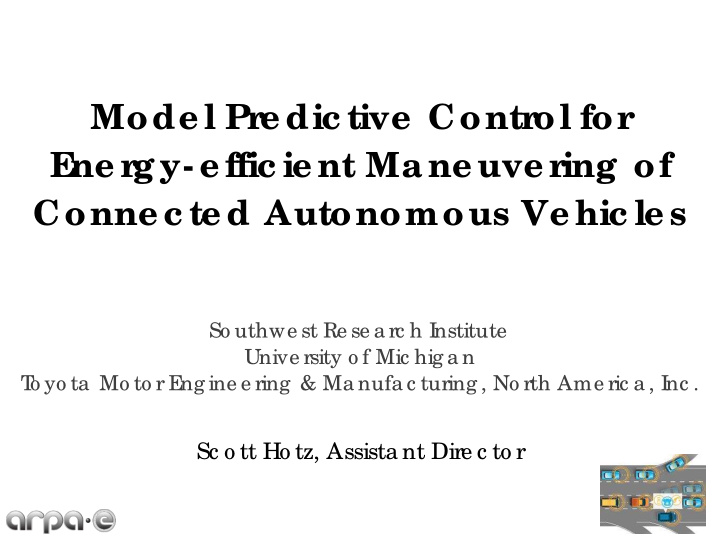



Mode l Pre dic tive Control for E ne rg y- e ffic ie nt Ma ne uve ring of Conne c te d Autonomous Ve hic le s So uthwe st Re se a rc h I nstitute Unive rsity o f Mic hig a n T o yo ta Mo to r E ng ine e ring & Ma nufa c turing , No rth Ame ric a , I nc . Sc o tt Ho tz, Assista nt Dire c to r
As the prime contractor SwRI The University of Michigan TEMA will serve in an advisory will leverage its expertise in brings a broad range of and support role as a passive CAVs, powertrains, and vehicle experience on advanced collaborator, and will provide and component evaluation. engine and vehicle controls. vehicles and instrumentation. • • • Vehicle Benchmarking Vehicle Model OEM Vehicle Integration • • CAV Development Development Powertrain Model • • Traffic Simulation Traffic Flow Information Validation • • • CAV in the loop dyno Traffic Data Analysis Bypass Control Assistance • • testing Mcity Automated Vehicle Production Implementation Test Facility Perspective • Optimal Control Algorithm Development • Powertrain Optimization
20% Energy Consumption Reduction CAV Enabled Toyota Prius Prime PHEV Predictive VD & PT Control Structure Realistic Traffic Simulation Generate Road Networks Trip Energy Management Macroscopic: utilize V2C Develop Traffic Volume SOC SOC Planning Expand SOC Limit 7% Distance Validate Traffic Model 3% Driving Power Management Mesoscopic: utilize V2V and V2I Vehicle Simulation 3D Vehicle Simulation 35 25000 Pwr/Spd 20000 30 15000 25 10000 Optimization 20 5000 15 0 -5000 10 -10000 5 -15000 10% 0 -20000 1 101 201 301 401 501 601 701 801 901 1001 1101 1201 1301 1401 -5 -25000 Speed (MPH) Traction Motor Power (watts) Reaction Motor Power (Watts) Battery Power (Watts) Human Driver Advisory Automated Driver
Precision CAV Chassis Dyno Testing Simulated Traffic Simulator DSRC RF Coverage/ Vehicle speed/ position, Speed Roadside and Signal Phase and Timing, Vehicle speed Vehicle Unit Road type/ grade Dyno Controller Powertrain DSRC States ECU Bypass Onboard Unit VD&PT Control Energy Management ECU Safety Position Constraints Engine on/off Engine torque DRCC Subsystem ECU Radar MG1 torque System MG2 torque Power friction brake Request
Technology-to-Market approach o The Technology-to-Market (T2M) plan will be developed during the first quarter of this effort o SwRI will identify an internal T2M lead, and is evaluating options for external support o This technology will be developed in a way that minimizes the barriers to entry into the market This technology will initially be applied to a human driven vehicle Later integrated into an automated vehicle o Market Discovery and validation Do drivers want this? Are there other markets to consider? Are NEXTCAR assumptions valid? What is the energy cost of CAV tech?
Key Challenges o Will the algorithms be robust to any changes in parameters or uncertainties, penetration rate, any delay in the system? o Can the optimization problem be solved quickly for real-time implementation? o Are there any opportunities to improve engine efficiency in this highly optimized PHEV?
Recommend
More recommend